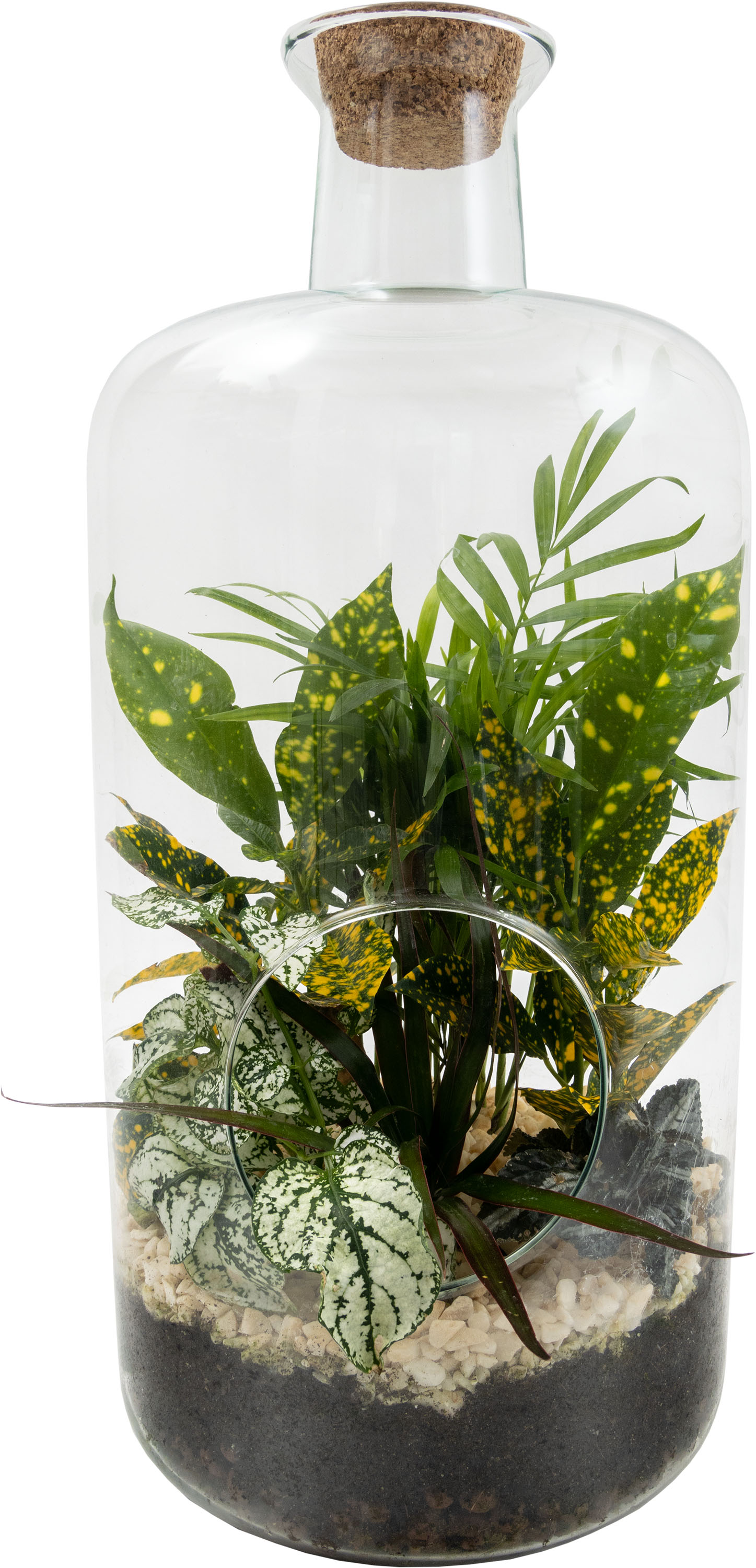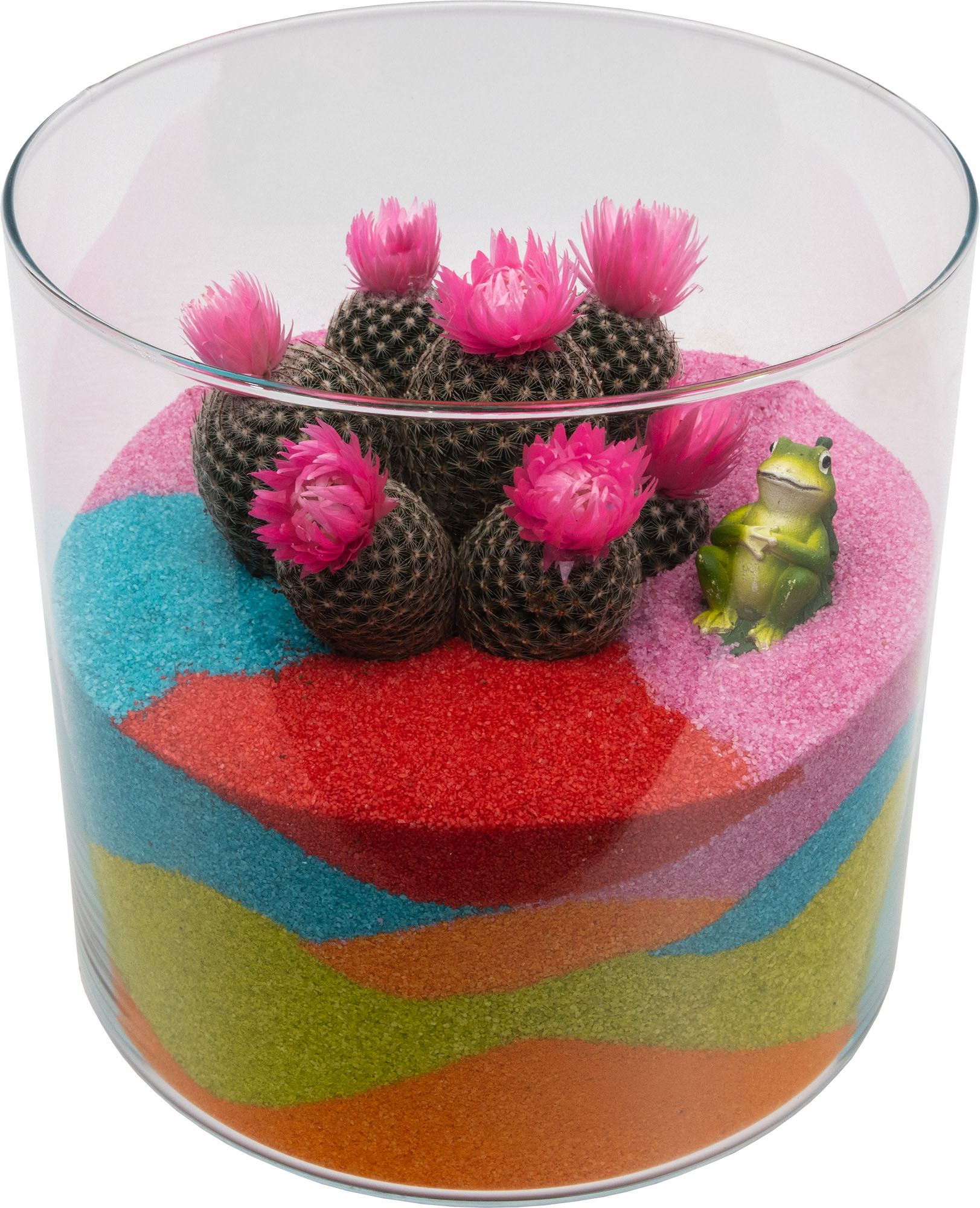Terrariums
A terrarium is a collection of small plants grown in a usually transparent or green glass container with no drainage. This lack of drainage is what makes terrariums special in terms of putting them together and caring for them. Additionally, the glass container is often a closed bottle in which case the terrarium is often referred to as a bottle garden.
What is a terrarium or bottle garden? – A terrarium is a collection of small plants grown in a usually transparent or green glass container with no drainage. The lack of drainage is what makes the terrariums special in terms of putting them together and caring for them. Additionally, the glass container is often a closed bottle in which case the terrarium is often referred to as a bottle garden.
This guide will aid you in creating your unique piece of horticultural art.
What you will need:
- A Glass Container – There are plenty of unique containers from which to choose. Any container that is deep enough to accommodate the drainage layer and has an adequate depth of potting mix to accommodate plants will give your plant a higher chance of reaching its maximum growing potential.
- Small Stones or Pebbles – These will be used as the base of your terrarium, and act as the drainage layer for your plants’ roots to ensure that excess water doesn’t stay within the soil and cause odour and rot.
- Activated Charcoal – A thin layer of activated charcoal keeps the water fresh and helps to fight off bacterial growth and odours in your terrarium.
- Potting Mix – Cactus Focus Repotting Mix Peat Free is ideal for both open and closed terrariums due to its superior drainage and absence of perlite.
- Plants – Your choice of plant needs to be an appropriate size which will allow growth to be compact and consistent. Air Plants, succulents and mini cacti are all perfectly viable options. To see a complete list of plants recommended by us, use the “Selecting Plants” tab.
- Small Gardening Tools – Keeping small tools handy will allow you to help create and situate all the items within your terrarium, especially if you cannot get your hand into the opening.
Putting the Terrarium Together:
You will need to consider how the terrarium will be displayed. Will it have a front and back? Or will it be visible from every angle? This will determine where the taller plants should go, i.e., at the back or in the centre. It is good practice to place the plants in the container before you start and see how they will look best together.
- Cover the bottom of the container with a 1–2-inch layer of small stones or pebbles. This will act as the drainage layer for your terrarium.
- Add a thin layer of activated charcoal, about one teaspoonful per five litres of container volume.
- Add a layer of potting mix. You must ensure enough potting mix is added so that it is deep enough for your plant's roots to grow. Generally, this layer needs to be around 1-3 inches.
- Time to plant! Remove the plants from their pots and remove any soil you can without disturbing the roots. Cacti and succulents are best repotted on the dry side, but most other plants are best planted after they have been watered the day before. Make a hole in the soil large enough to fit the plant’s roots. Next, nestle the plant into the soil. It’s easiest to work your way from the back to the front of the terrarium, however, there are no rules when designing the terrarium. Play around with the arrangement and mix things up. Most importantly, have fun!
- After all your plants are arranged in your glass vessel, complete the look with a layer of decorative gravel. We recommend small-sized, light-colour gravel for the best look.
.jpg)
Many open terrariums can tolerate some direct sunlight. However, this heats the container and the rootzone which beyond a certain point is harmful to the plants. Leaving terrariums in direct sunlight can cause the glass to become extremely hot which in turn can scorch the plant's leaves, leaving lasting damage.

You should place your terrarium in an area with bright light conditions, but not in direct sunlight. If over time you notice the plants within the terrarium leaning towards the light source, this is an indication the lighting conditions are not bright enough and can cause loss of variegation. A yellowing leaf is an indication there may be too much light.

Lightly water the terrarium every two to four weeks, or once the soil looks as though it has dried out. Using the stream mode of a mister or heavy misting is a good way to water, giving even coverage and allowing the soil to drain the water correctly down to the drainage layer.

Often you may see droplets of water on the glass surface inside your closed terrarium. In this case, open the container for a day or two. It is always a good idea to open the container for one to two days after watering or from time to time, this will allow fresh air inside the closed terrarium which will aid plant growth.

When selecting plants for your DIY terrarium, there are a few things to keep in mind:
- Choose plants that are small enough for your glass vessel. You do not want any greenery touching the sides of the container as the plant may feel cramped or receive scorch damage from the temperature of the glass.
- Plants that do well with humidity such as ferns, African violets, Venus flytraps, starfish plants, air plants, baby’s tears, fittonia, golden clubmoss, and strawberry begonia will thrive in a closed terrarium. Plants such as cacti do not do very well in a terrarium with a lid.
- Most plants will do well in an open terrarium.

Using the correct products is key to keeping your terrarium fresh and allowing the maximum growth potential:
Terrarium Focus Repotting Mix Peat Free: Designed for best results with closed and open terrariums.
Decorative Grit – Tuscan: An ideal top dressing. Ensured the grit is washed and graded between 3-8 mm.
Terrarium Activated Carbon (Charcoal): This lightweight and highly absorbent Activated Carbon has added oxygen which increases its porosity and surface area. Made from organic material, it can absorb 100 to 200 times its weight and draws out organic chemicals and bacteria for a clean, odour-free terrarium.
Houseplant Myst: Ideal for use with terrariums, Houseplant Myst provides essential nutrients within its stream which ensures water spreads correctly within the potting mix.
BetterGrow Pruning Scissors (Straight or Curved): Ideal for pruning some of the plants within the terrarium, these Pruning Scissors encourages compactness which prevents an overcrowded display. With a choice of straight or curved blades for even finer precision.
SB Plant Invigorator: A unique 3-in-one pesticide, mildewcide and foliar feed for all plants. Controls mealybug, Spider mite, aphid and whitefly infestations. SB Plant Invigorator is suitable for use throughout the year – no harvest interval for edible crops and is safe to use at home.

Click here to download a leaflet - Making The Most Out of Your Terrariums & Bottle Gardens.
Check Out Our Product Range Here
You can contact us by email at: enquiries@growthtechnology.com
Your login details have been used by another user or machine. Login details can only be used once at any one time so you have therefore automatically been logged out. Please contact your sites administrator if you believe this other user or machine has unauthorised access.

